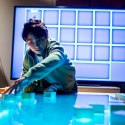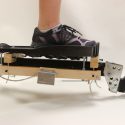Researcher says for 2-year-olds, touch screens may trump TV

New research shows that for children under 2 1/2 years old, interactive screens such as those on smartphones and tablet computers may be better teaching tools than educational television.
Photo: iStock Photo
Smartphones and tablets may be better learning tools for toddlers younger than 2 1/2 years old than “Sesame Street” and other educational TV programs, according to a researcher in the UW–Madison School of Human Ecology.
“Some of our research is starting to show that even a young 2-year-old might be able to learn from interactive screens,” says Heather Kirkorian, assistant professor of human development and family studies. “Just as ‘Sesame Street’ has closed education gaps for low-income children during the preschool years, we might be able to benefit even younger kids if we can use interactive media in the same way.”
Kirkorian conducts eye-tracking research to understand how children learn from screen media. Her research often takes place in a small room with a TV on a desk with small cameras in front of the TV and pointed at the viewer. The cameras record reflections off the cornea and retina, which track and register where the eyes look on the screen.

Heather Kirkorian
In some of Kirkorian’s studies, children are watching “Sesame Street” and other shows to determine how viewers of different ages watch television. In other studies, children watch simple displays created in the lab, such as an adult hiding a sticker on a felt board — either on TV or in person. Later, the researchers ask the children to find the sticker.
Another focus of her research is on learning from interactive versus non-interactive video.
“We’re using touch screens to manipulate whether kids just watch a video presentation or whether they have to interact with it in some way to see what happens next,” Kirkorian says.
Kirkorian, who directs the Cognitive Development & Media Learning Lab, aims to link attention while kids are viewing to their subsequent learning. The questions specifically behind this research are: While a 2-year-old is watching a video, what are they looking at; and does that predict what they learn from that video?
Young children do not watch TV the same way that adults do, Kirkorian says.
“Adults are very systematic when they watch television. They look at the same thing as each other. That’s a bit less true for 4-year-olds and very much less true for infants.”
“Just as ‘Sesame Street’ has closed education gaps for low-income children during the preschool years, we might be able to benefit even younger kids if we can use interactive media in the same way.”
Heather Kirkorian
The video deficit, which Kirkorian defines as “a very robust phenomenon that until about 2 1/2 to 3 years of age, kids learn much less from video than a real-life demonstration,” ties these two areas of research together.
“Even though my research is very basic, I’m addressing big research questions, so it’s very applicable,” Kirkorian says.
Her work has gained attention in the National Journal and The Atlantic, and a paper she co-authored, “The Effects of Background Television on the Toy Play Behavior of Very Young Children,” was downloaded more than 3,000 times.
Media producers and educators are only two of the potential users of this research. “We hope that parents can use this research to decide whether, how, and how often they choose to use media in the home,” Kirkorian says. “We also hope that policymakers might use this research to inform their decisions.”
The effectiveness of her research relies on extensive interaction with children and students, and for Kirkorian that is the best part of her job.
“One of the things that is most rewarding is just being able to work with kids in the lab and being able to see what they do,” Kirkorian says. “It always becomes much more meaningful when research comes to life and you see what kids are actually doing. Related to that is working with students — both grad and undergrad — in my lab for the same reason. It allows me as an instructor to bring research to life for them.”
—Hayley Kuepers
Tags: children & families, computers, learning, research, technology


